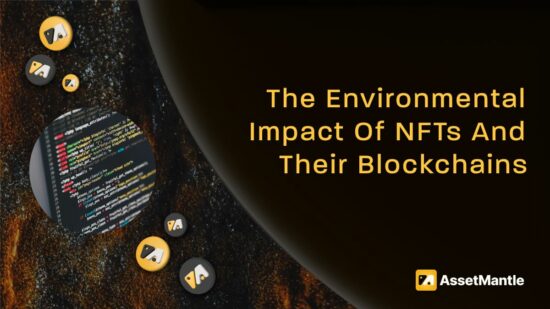The entire cryptocurrency and NFT market have been on an incredible bull run since early 2020. To put this into perspective, the cryptocurrency market cap exploded from around $200 billion in 2019 to over $2 trillion in 2021, a 10x increase, according to Morning Brew.
Further, according to the latest 2021 NFT market report by Chainalysis, the NFT marketplace saw an influx of cryptocurrencies worth over 44 billion on just the Ethereum network (ERC-721 and ERC-1155 smart contracts).
As a result, there have been several concerns regarding the environmental impact of the blockchain industry that accompanies its heavy computation to maintain privacy and security.
Raising awareness regarding the environmental impact and carbon footprint of different cryptocurrency and non-fungible token (NFT) protocols is a crucial element of the greater blockchain movement. As more people start using cryptocurrencies, they need to do so with an understanding that their activity has a real-world impact.
For instance, a single transaction on the Ethereum blockchain consumes more energy than 100,000 VISA transactions, according to research published in January 2022.
The Mantle team firmly believes in having a positive impact on the environment. As such and given the discussions surrounding blockchain in the last years, this post is dedicated to exploring in more detail the topic of carbon footprint and energy consumption by different NFT protocols.
Why Do NFTs Consume a Lot of Energy?
Non-fungible tokens (NFTs) are digital assets on the blockchain whose ownership can be verified and whose provenance can be tracked.
It is very probable for the uninformed public to assume that NFTs leave a very small carbon footprint as they are merely digital files. But that is only partially true.
While NFTs consume very minimal energy when they are just stored on the blockchain, it is their ‘usage’, transaction, and creation (minting process) that leaves a heavy environmental impact in most cases.
Read more on what are NFTs and how to create them.
In simpler words, the technology behind NFTs needs a significant upgrade in order to reduce their carbon footprint.
Behind the Scenes of NFTs — Technology
Most NFTs, today, are minted on the Ethereum network that uses the Proof-of-Work (PoW) consensus model.
The Proof-of-Work consensus, by nature, is designed to maximize security with no regard to environmental impact. Thus, with about 80% of the NFT market share currently being on Ethereum, there is a need for upgrades and environment-friendly alternatives.
In the PoW model of securing the blockchain, all miners participate (or race) to solve mathematical problems through a trial and error method. The miner that solves the problem first is rewarded with the chain’s native token while others are left out. Therefore, the energy consumed by all the other miners was for naught.
Hence, there is an ever-increasing need to use faster and better processors, that inadvertently consume more energy, to mine faster and earn more rewards.
While on a small scale this might not seem too big of a concern, on a global scale it is.
The analogy can be made with regular computers. For example, what if every desktop, laptop and smartphone in the world had to be run just to process a $10 payment that one person is sending to their friend as a gift? Similar is the case with Ethereum.
Nevertheless, with Proof-of-Stake (PoS) consensus model, the consumption of electricity to mint assets on the blockchain has decreased manifold.
For the same reason, the Ethereum network is in a transition towards adopting the PoS model. However, it is unclear as to when exactly that would happen.
In the PoS model, the validators, in a way, collateralized the chain’s native token through ‘staking’ and the node that would validate is chosen through randomization algorithms that also take into account the past performance of the validators. Hence, all validators are not required to work for all on-chain transactions.
Some chains like Mantle, Stargaze, and Near are already using PoS or its modifications, like DPoS, for minting and trading NFTs.
Energy Consumption of Ethereum and ETH-Based NFT Platforms
Ethereum is the second-largest blockchain by market capitalization and the first to introduce smart contracts, which ultimately birthed NFTs.
Ethereum was born out of the need to revolutionize not just currency in its rudimentary form of give-and-take, but the entire financial system. This led to the emergence of Decentralized Finance (DeFi).
However, Ethereum, like Bitcoin, also uses the PoW consensus model. As a result Ethereum now consumes over 100 Terra-watt hours of electrical power per year, which is in the ballpark of 7.5% of India’s power consumption.
Further, a single transaction on Ethereum consumes more power than 160,000 VISA transactions. To put this into perspective, it is equivalent to about 6 days of average household power consumption in the US.
Ethereum 2.0, however, could bring down the energy consumption by approximately 99.95%, according to an article published on Ethereum Foundations blog.
OpenSea Energy Consumption
Being the world’s first and currently largest ETH-based NFT platform, OpenSea leaves the largest carbon footprint among all NFT marketplaces.
According to Aerial, OpenSea’s activities amounted to over 65 million kilograms of carbon emissions since its marketplace launch.
Energy Consumption of Binance Smart Chain and Binance NFT
Binance Smart Chain (BSC) is a layer-1 blockchain of Binance (the world’s largest centralized cryptocurrency exchange). It runs parallelly with the Binance chain to facilitate EVM-compatible programmability and interoperability.
Unlike Ethereum, BSC utilizes a combination of the PoS and Proof-of-Authority (PoA) consensus algorithm called ‘Proof-of-Staked Authority (PoSA)’.
As a result, Binance occupies a middle ground in this space. It is not the most energy-efficient but also consumes far lower power compared to chains like Ethereum and Bitcoin.
Estimates suggest that the yearly power consumption of BSC is about 438 kWH; over 300 million times lower than the yearly power consumption of Ethereum.
Interestingly, the power consumption of BSC is so less that Association pour le développement des actifs numériques (Adan), a French blockchain association, considered the energy consumption of BSC to be ‘negligible’.
Energy Consumption of Blockchains in the Cosmos Ecosystem and their NFT Frameworks
The Cosmos ecosystem is a decentralized network of independent, parallel blockchains. Its native token is ATOM.
ATOM staking on the validator nodes of the Cosmos ecosystem secures the network and forges new blocks. The consensus algorithms used by these chains in the Cosmos ecosystem are Tendermint BFT and its fork HotStuff.
Tendermint BFT is a variant of the PoS consensus model and is known for its high transaction speed and finality.
HotStuff, on the other hand, uses a more energy-efficient method called ‘gossip protocol’ for block propagation. As a result, it consumes about 10 times less power than Tendermint BFT.
The energy consumption of the Cosmos ecosystem is, therefore, lower than that of Ethereum and other PoW-based blockchains.
NFTs on MantlePlace
MantlePlace is the NFT marketplace of AssetMantle running atop the Mantle chain.
Mantle is a layer-1 blockchain that uses the Proof-of-Stake consensus model. It is built on Tendermint using the Cosmos-SDK.
The yearly power consumption of Mantle and NFTs on MantlePlace is yet to be accounted for. However, certain calculated assumptions can be made in this regard with existing data.

According to the Cosmos blog, it would take more than 100,000 Cosmos blockchains to match the yearly power consumption of Ethereum. Therefore, the power consumption of Mantle place could be in the ballpark of 0.00001 times of Ethereum.
Energy Consumption of AssetMantle — An Estimate
To estimate the energy consumption of AssetMantle, the Mantle team would be referencing the Crypto Carbon Rating Institute’s (CCRI) report published in January of 2022.
Below is the publicly available data of AssetMantle as of early May 2022:
- Number of validator nodes = 5
- Number of sentries = 20
- Validator nodes’ minimum requirement (with pruning): 4vCPUs and 8GB RAM, 200GB
- Validator nodes’ minimum requirement (without pruning): 4vCPUs and 8GB RAM, 500GB (extendable up to 2TB)
- Sentries nodes’ min requirement: 2vCPUs and 4GB RAM, 200GB SSD
- Additional Cloudflare services
- Additional servers for protection against attacks and incidents
By referencing tables 4, 14, 15, 16, 17, 18, and 19, it can be approximated that each node consumes about 16.1 Watts of power. This would accumulate to approximately 141 kWh/year.
Therefore, the total power consumption of 25 nodes in a year is approximately 3.525 MWh.
Conclusion
All in all, NFTs can thrive while being environmentally friendly through better consensus models and protocols.
It is important to note that the power consumption of these protocols is not an accurate representation of their carbon footprint. The carbon footprint of these networks would be greater than what could be accounted for. This is because their impact on the environment would also include indirect factors like electricity production, manufacturing of hardware, and so on.
Nevertheless, environmental considerations should be taken into account while designing these protocols to make them truly sustainable.

About AssetMantle
AssetMantle is a multi-tenant NFT marketplace framework that enables creators and collectors to securely mint, own, and trade digital assets on its fast-finality blockchain. The AssetMantle no-code toolset allows creators to create customized assets and marketplaces permissionless-ly . Likewise, collectors can own the assets minted across these marketplaces and compatible chains in a singular wallet with minimal gas and a lower carbon footprint. Built on the interNFT standard, AssetMantle implements an end-to-end stack of open-source modular tools that developers can modify to fit advanced use cases.
contribute to interchain NFT standards; currently being spearheaded by us & the interchain foundation: https://github.com/interNFT/nft-rfc/tree/main
Vision
Build an open-source, community-driven framework for inter-chain NFTs and metadata standardization by contributing to the ‘interNFT standard’.
Mission
Provide a platform that enables a diverse set of NFTs use cases that extend beyond arts and collectibles and can potentially change the representation of rights and ownership of real-world assets like real estate and other commodities.

AssetMantle is always on the lookout to connect with individuals or organizations who wish to take advantage of the opportunities present in the blockchain space and want to learn more about AssetMantle. If you wish to get in touch, please do not hesitate to reach out.
Follow AssetMantle’s social channels to stay up-to-date with the latest developments.
Twitter | Telegram | Discord | Instagram | LinkedIn | hello@assetmantle.one




